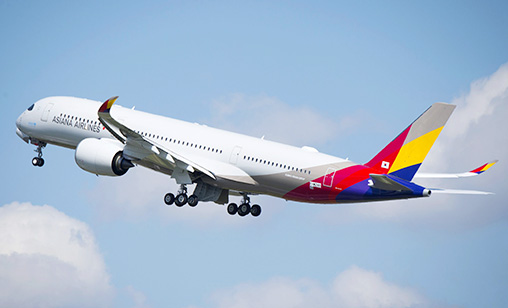News Backgrounder
More Asia-Pacific carriers to follow example of Korean Air-Asiana merger?
Korean Air parent, Hanjin Kal, intends to take over Asiana Airlines but the deal faces hurdles to reaching the finishing line. If successful, will it be a foretaste of post-pandemic airline consolidation? Associate editor and chief correspondent, Tom Ballantyne, reports.
December 1st 2020
As Korean Air (KAL) parent, Hanjin Kal, seeks to overcome opposition to its proposed takeover of Korea’s second international carrier, Asiana Airlines, chief analyst at aviation data group OAG, John Grant, has raised the possibility of more airline mergers post the passing of the COVID-19 pandemic. Read More »
“Perhaps this is the tip of a global consolidation iceberg. Are others about to happen?” Grant has posited. “Could Emirates and Etihad finally be a play? Could Singapore Airlines acquire Malaysia Airlines? Is there one final U.S. consolidation among tier-two carriers? And how many mid-size European legacy carriers would love an approach from someone? Almost anyone! These consolidation plays could be very interesting. As always, only time will tell,” he said.
 |
It is not likely in the Asia-Pacific, said Asia Pacific Airlines (AAPA) director general, Subhas Menon. “It is very difficult to see airlines pursuing mergers and acquisitions at the moment. They are focused on survival. They are concerned with conserving cash and withstanding this crisis. Consolidation, in the usual sense of the word, will not be a widespread phenomenon,” he said.
International Air Transport Association regional vice-president Asia Pacific, Conrad Clifford, has a different view. He said it was “highly likely” there will be more consolidation in the region. “If you look at Korean Air and Asiana year ago, who would ever have thought the Korean government could have remotely agreed to a merger between those two carriers?” he said at an online media briefing last month.
“But that’s where we are today. It reflects a realistic approach to the fact airlines around the world are in very poor financial condition. In many cases, that means that consolidation. Mergers make a lot of sense.” Clifford said the move was a “good example” of airlines getting in the midst of a very difficult market to ensure their survival and the continuation of jobs and employment for their staff.
In the meantime, Hanjin Kal’s bid to acquire Asiana for $1.6 billion has encountered its first hurdle since Asiana’s main creditor, the Korea Development Bank (KDB), agreed to inject $723 million into Hanjin Kal through a rights offering and convertible bonds. Hanjin Kal will then participate in a stock sale that will be used to acquire Asiana.
A day after the deal was signed, local equity fund, Korea Corporate Governance Improvement (KCGI), a major shareholder in Hanjin Kal and an objector to the deal, filed an injunction against the KDB’s plan to join the rights issue. It said the share sale designated to a third party would damage the firm’s existing shareholder value. If the court accepted the fund’s injunction request, the deal would fall apart and Asiana would return to the control of its creditors.
 |
If the transaction goes ahead, it remains fraught with risk, not the least being turning pandemic losses into profits. KAL’s net losses narrowed to $590.7 million from January to September this year, from $641 million a year earlier. Asiana’s net losses deepened to $565.4 million, from $475 million, in the same period.
To complicate matters, Hanjin Kal and KAL chairman, Walter Cho, has volunteered to step down if the merged airline reports poor earnings on his watch. He also has offered his 6.52% equity in Hanjin Kal as security for creditors. It is a game decision. In the global health crisis of 2020, when both carriers’ international operations are severely curtailed by the pandemic, short-term profits will be hard to come by.
Merging two airlines with different cultures and fleets also will be a challenge as history has shown. When Australia’s Qantas Airways absorbed government-owned domestic airline, Australian Airlines, it took several years to bed down an integrated structure. The same was true when Air India subsumed Indian Airlines.
In 2019, Grant pointed, KAL ranked 27th and Asiana Airlines 40th on global airline tables. If successful, the consolidated carrier will leap frog to 16th, ahead of Cathay Pacific Group and slightly behind Air France KLM.
“The two airlines fly to 141 cities. Fifty nine are operated by both carriers, which suggests a high level of network duplication,” Grant said. “Between them, they have about 27,000 staff. It is estimated there will be up to 1,000 overlapping employees after the merger. “Downsizing employees almost certainly will spark issues with unions, although KAL’s Cho has said while there may be concerns about a monopoly, ‘there will be no lowering of customer convenience or price hikes’.”
Last month, Cho said “we have no plans to restructure our workforce. We will create an opportunity to embrace all employees and welcome them as a family. I will do my best to ensure no one is left behind. I will meet (the unions of both companies) as soon as possible and find a way to coexist”.
 |
KAL and Asiana have a collective fleet of 247 aircraft. KAL’s airplanes are primarily Boeing. Asiana’s fleet is mainly Airbus. “Selecting the preferred long-haul twin engine fleet may present a challenge for the merged carrier,” Grant said.
“Asiana Airlines has a preference for the A350 while Korean Air is wedded to the 777 for much of its intercontinental network. For many carriers, a mix of aircraft types, and more importantly, the flexibility to right size capacity to new market sizes, will be important in the recovery phase. The new Korean Air may have struck lucky on that point.
“Collectively, the two carriers have established a leading market position with their dedicated (cargo) fleets operating globally with scheduled and charter services. Korean Air’s cargo services effectively ‘saved’ the airline in the summer as COVID-19 PPE supplies were moved in vast quantities. “Asiana enjoyed a similarly successful cargo summer.”
The SkyTeam alliance could win big from the merger. “With Korean Air staying in SkyTeam and over time the merging of Asiana Airlines into it, there will be a powerful hub and a larger access point in Northeast Asia for all SkyTeam members. Suddenly, from holding a 33.6% capacity share in 2019, SkyTeam will have approximately 51.2%, a position the alliance only could have dreamed before the merger,” Grant said.
| Incheon Seoul to win big from merger of Korea’s international carriers Another winner in the combined carrier scenario will be Korea’s leading international hub, Seoul Incheon Airport. “Opened in 2001, Incheon always had the potential to be a global hub airport, but it has been held back in achieving that objective because it has two moderately sized carriers with similar networks. For instance, great circle routings allow Incheon to be one of the most effective transit points from the UK to Australia with a circuitry of 101%; better than that offered via any Middle East hub. Only Shanghai is better,” said OAG’s John Grant. “With Incheon offering connectivity to some 44 cities in China in 2019, of which 34 were operated by either Korean Air or Asiana Airlines, the scope for expansion post COVID-19 into the world’s largest market will provide opportunities to enhance Incheon as a major global hub. “It will also benefit the Seoul airport from the potential for a combined airline to reschedule some of the major international flows. In 2019, both airlines were operating services to destinations such as Frankfurt and Paris within two hours of each other and under a combined operation the possibilities of double daily, night and daylight services will improve connectivity.” |